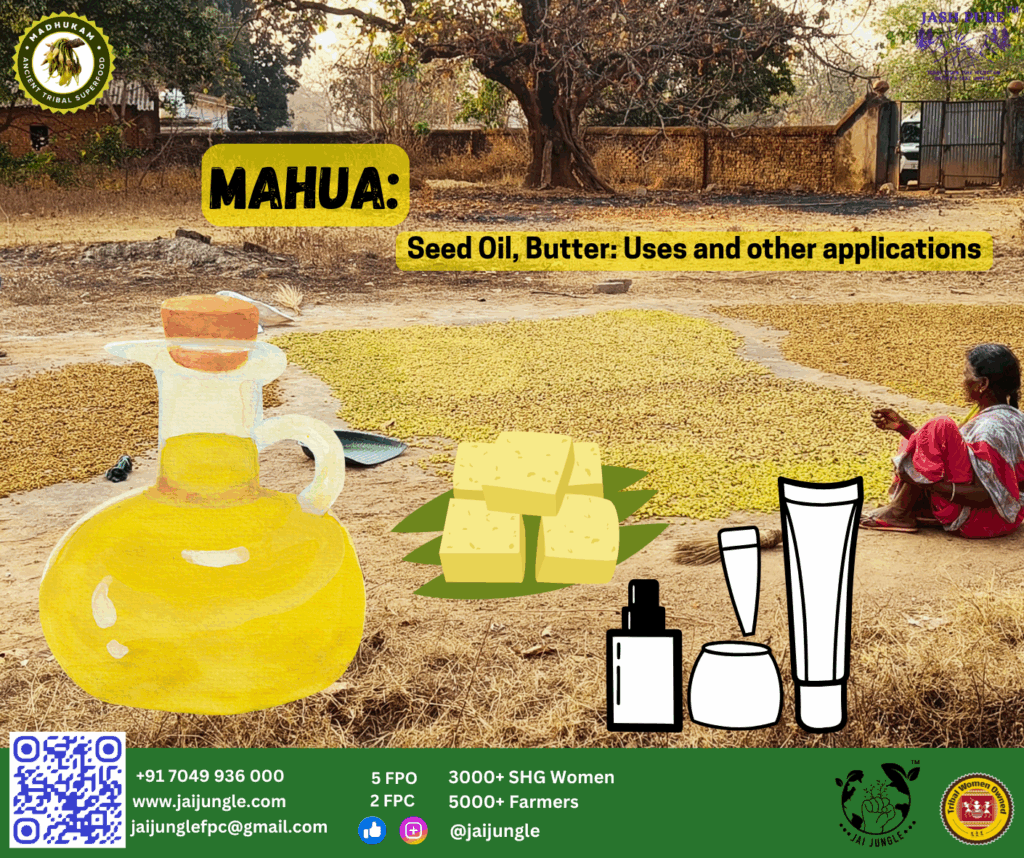Seeds of Hidden Strength
When people speak of Mahua (Madhuca longifolia), they often focus on its blossoms: sweet, fragrant, and culturally central. But in the shadow of these flowers lies another treasure — the Mahua seed. Contained within the fruit that ripens in May–June, these seeds carry 33–61% oil (Patel & Naik, 2010), making Mahua one of India’s most oil-rich non-timber forest products (NTFPs).
For centuries, Mahua oil has lit lamps, filled cooking pots, soothed aching joints, and nourished skin. Today, it is also recognized for its potential in food processing, cosmetics, pharmaceuticals, and renewable energy. In this blog, we explore Mahua seeds — their traditional uses, phytochemistry, modern applications, by-products, and sustainability challenges — while highlighting Jai Jungle’s ongoing work to reposition Mahua in women-led value chains.
Traditional Context – Oil of the Forest
In Tribal Kitchens
Ethnographic surveys across Chhattisgarh, Odisha, Madhya Pradesh, and Jharkhand document that Mahua oil was once routinely used in cooking. Tribals cold-pressed seeds in wooden or stone ghani (oil expellers), producing a yellowish fat used for:
- Frying rotis, vegetables, and snacks (Ahirwar et al., 2018).
- Emergency food during lean months, when no other fat source was available.
- Ceremonial cooking, especially for community feasts.
Over time Mahua oil lost culinary prominence. Today, it is rarely eaten, but older generations recall it as a household staple.
Oil as Light and Medicine
- Lamp oil: Before electrification, every tribal household lit Mahua oil lamps.
- Medicinal oil: Warmed oil was applied to joint pain, rheumatism, cracked skin, and burns (Sinha et al., 2017).
- Folk uses: Oil was even administered for piles and skin infections.
These practices highlight Mahua’s multifunctional role in forest communities: food, fuel, and pharmacy.
Phytochemistry – Why Mahua Oil Works
Scientific studies explain Mahua oil’s wide utility through its unique chemical composition.
Fatty Acid Profile (approx. %)
- Oleic acid (41–52%) → stable, heart-healthy, moisturizing.
- Stearic acid (20–25%) → solid at room temperature, gives Mahua butter firmness.
- Palmitic acid (20–25%) → common saturated fat, improves texture.
- Linoleic acid (8–10%) → omega-6 fatty acid, essential for metabolism.
(Patel & Naik, 2010)
Unsaponifiable Matter (~2–3%)
- Tocopherols (Vitamin E) → antioxidant, protects oil from rancidity.
- Phytosterols → cholesterol-lowering potential.
- Triterpenoids (lupeol, betulinic acid) → anti-inflammatory, analgesic, anti-cancer properties (Das, 2019).
Seed Cake Composition
After oil extraction, residual cake contains:
- Proteins (15–18%) → potential livestock feed.
- Fiber, sugars, tannins, saponins → require detoxification before consumption (Ahirwar et al., 2018).
This nutrient-phytochemical richness underpins Mahua’s diverse applications.
Mahua Butter – India’s Untapped Cocoa Alternative
At room temperature, Mahua oil solidifies into Mahua butter, a pale-yellow, semi-solid fat.
Comparison with Cocoa and Shea
- Cocoa butter (chocolate fat): Melting point ~34 °C.
- Mahua butter: Melting point ~32–34 °C — nearly identical, making it an excellent cocoa butter substitute in confectionery (Patel & Naik, 2010).
- Shea butter (Africa): Used in skincare and food — Mahua could be India’s shea butter equivalent, still untapped globally.
Cosmetics and Skincare
- Traditionally used for eczema, rashes, cracked heels, and skin hydration.
- Rich in stearic and oleic acids, modern formulations use Mahua butter in lotions, balms, and soaps .
- Jai Jungle has trialed Mahua butter in natural skincare prototypes — including hand balms and moisturizers — emphasizing women-led processing and safe, non-edible applications.
By-products – Closing the Circle
Nothing in Mahua seeds goes to waste.
- Detoxified seed cake → Protein-rich cattle feed.
- Compost/fertilizer → Improves soil organic content.
- Biogas substrate → Fermentation yields methane energy for cooking fuel.
- Mosquito repellent/insecticide → Cake burned in rural households or used in fields.
- Fish poison (ethnographic) → Used by some communities, though ecologically controversial.
These by-products represent traditional zero-waste resource management.
Modern Applications – From Food to Fuel
Food Industry
- Mahua butter studied as cost-effective cocoa butter equivalent in chocolates and bakery shortening (Patel & Naik, 2010).
- Use remains limited due to stigma around Mahua as “liquor tree.”
Pharmaceuticals
- Wound healing: Ointments with Mahua butter showed faster recovery in animal models (Das, 2019).
- Anti-inflammatory: Lupeol, betulinic acid reduce swelling and pain.
- Potential anti-cancer properties under investigation.
Renewable Energy
- Mahua oil transesterified into biodiesel achieves >90% efficiency (Jha et al., 2013).
- Pilot projects in Odisha and Chhattisgarh tested Mahua biodiesel in diesel engines, showing compatibility with rural transport and irrigation pumps.
Socio-Economic Dimensions
Household Level
Each mature Mahua tree yields 20–200 kg fruit annually, producing up to 20 kg oil (Sinha et al., 2017). For rural families, this has historically provided cooking oil, medicine, and light.
Women-Centric Value Chain
- Seed collection, drying, and oil pressing are women-led activities.
- Modern FPCs like Jai Jungle in Jashpur are reviving this knowledge — training tribal women in hygienic oil pressing and butter processing.
- Mahua oil is now being repositioned not just as heritage, but as livelihood empowerment.
Policy, Sustainability, and Challenges
Despite its richness, Mahua seed use faces hurdles:
- Neglect in policy: Flowers receive attention due to liquor excise revenue, but seeds remain ignored in forest produce policies.
- Toxicity of seed cake: Requires safe detoxification for wider use.
- Deforestation and climate change: Shrinking Mahua populations threaten sustainable harvest.
- Market barriers: Stigma around Mahua (linked to alcohol) hampers butter/oil’s entry into global markets.
Policy shifts — like recognition of Mahua as a multipurpose NTFP under Forest Rights Act — are critical for scaling seed-based value chains.
Global Potential – Cocoa, Shea, and Mahua
Globally, natural fats like cocoa butter, shea butter, and coconut oil dominate food and cosmetic industries. Mahua butter has comparable properties but lacks recognition. With standardization, certification, and branding, Mahua could join this league as a sustainable Indian forest butter.
Unlike imports, Mahua is native, drought-resistant, and women-collected, making it an ethical, fair-trade candidate for global supply chains.
Jai Jungle’s Vision – From Seed to Skincare
At Jai Jungle, Mahua seeds are not viewed as industrial waste but as forest gold. Women-led teams are exploring:
- Mahua butter for skincare — hand balms, foot creams, and soaps, blending traditional uses with modern formulations.
- Community processing units — cold-press machines and butter refining, ensuring safe, non-edible applications.
- Holistic value chain — seeds, flowers, and leaves integrated into women’s entrepreneurship ecosystems.
By focusing on non-edible, high-value uses (skincare, wellness, renewable energy), Jai Jungle seeks to revive Mahua seed potential while breaking free from the alcohol-centric narrative.
More Than Just Seeds
Mahua seeds symbolize the essence of the tree itself: nourishing, healing, and empowering. From edible oil and skin balms to cattle feed and biodiesel, the seed’s utility spans food security, medicine, energy, and livelihoods.
By uniting ancient tribal knowledge, modern scientific validation, and women-led entrepreneurship, Mahua seeds can be repositioned as India’s answer to cocoa and shea butter — a global natural product with deep local roots.
In the future, Mahua seeds may not only empower rural women but also represent India’s contribution to sustainable food, cosmetic, and energy industries. Truly, a seed of opportunity.

